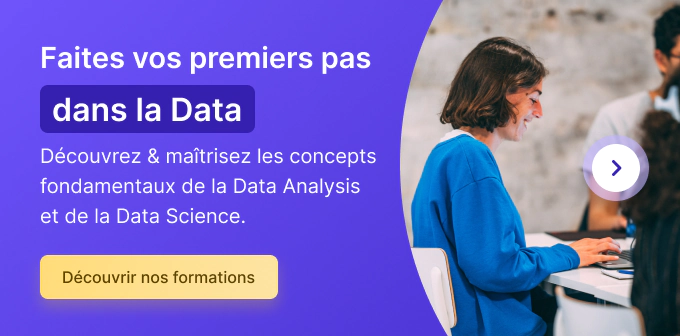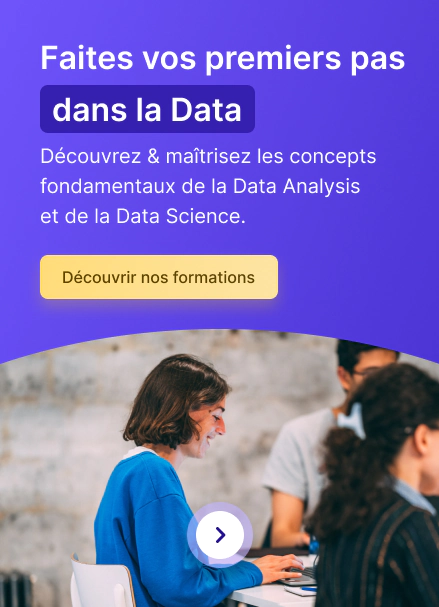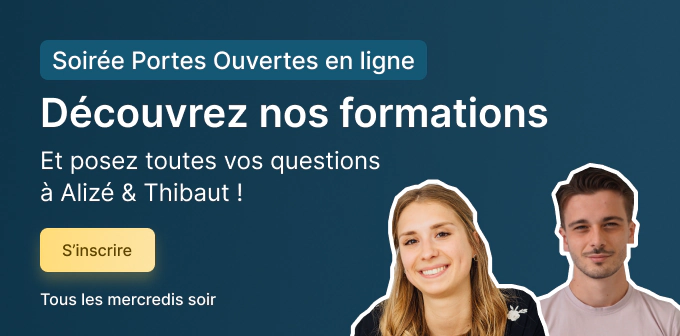Data Science : définition, applications et technologies

Sélectionnez un chapitre
La Data Science et ses applications font désormais partie de notre quotidien. On entend parler tous les jours, et à toutes les sauces : Intelligence Artificielle, Big Data, Machine Learning. Mais comment s'y retrouver ? On vous aide à vous y voir plus clair en répondant à vos principales questions : qu'est-ce que la Data Science ? Comment ça fonctionne ? Quelles sont ses applications ? Et bien plus !
Qu'est-ce que la Data Science ?
La Data Science rassemble un ensemble de méthodes et outils permettant l'extraction, la manipulation, l'analyse et l'interprétation de grands volumes de données. Elle fait appel à des compétences en mathématiques, en statistiques, en programmation et en visualisation de données pour résoudre des problèmes complexes et prendre des décisions.

Comment schématiser la Data Science ?
Une des raisons pour lesquelles la Data Science et ses métiers sont aussi sollicités sur le marché, c’est la transversalité des compétences que demande la maîtrise de la discipline. Finalement, la Data Science se trouve au croisement de trois grands pans, tout à fait complémentaires dans le cadre d’un projet Data.
Quelles sont les applications de la Data Science ?
Les domaines d'application de la Data Science sont nombreux, allant de la finance à la santé en passant par l'énergie et les médias sociaux. Les applications de la Data Science sont innombrables et font désormais partie de notre quotidien.
- La reconnaissance d’images de Facebook : plus besoin de rentrer le nom des personnes tagguées sur une photo, Facebook le fait pour vous, n’est-ce pas ?
- Netflix : un moteur de recommandation crée sur la base de ce que vous avez déjà aimé, ou regardé précédemment !
- Uber : l’algorithme d’Uber permettra à votre chauffeur de prendre une personne en plus sur son chemin sans vous faire faire de grand détour.
En entreprise, ces mêmes applications sont tout aussi utilisées à 4 fins distinctes – entre autres – :
- La prédiction de phénomène comme prédire un comportement d'achat sur des produits données
- L'optimisation de processus comme la détermination d'un prix
- L'automatisation de tâche comme la conduite automatique
- La création de nouvelles données par exemple avec l'utilisation des GAN
Quelles sont les différences entre l'Intelligence Artificielle, le Big Data et la Data Sciences?
Ces mots clés font partie du jargon de la Data Science, et contrairement aux idées reçues ils se différencient largement les uns des autres !
La particularité de l’Intelligence Artificielle réside dans l’ensemble des techniques utilisées pour imiter les mécanismes du cerveau humain, que ce soit pour faire de la reconnaissance d’images avec le Deep Learning, réaliser des modèles de prédictions sur divers phénomènes grâce au Machine Learning (météo, comportement d’achat etc), ou bien traiter du texte pour par exemple repérer des commentaires abusifs. Les applications en sont innombrables, d’autant plus que les technologies nécessaires sont accessibles à tout un chacun.
Quant au terme de Big Data, ilse réfère à l’ensemble des méthodes utilisées pour analyser un volume bien plus grand de données. Alors que les outils classiques de gestion de données ne le permettent pas, évoluer dans un environnement Big Data requiert des puissances de calcul bien plus grandes.
Les technologies utilisées en sont différentes. Etoffez vos connaissances sur le Big Data avec cet article.
Enfin, on nous demande régulièrement la différence entre Data Science et Business Intelligence, ou entre la Data Science et l'analyse de données : à chaque fois ce sont des concepts cousins mais pas identiques !
Quelles sont les principales technologies utilisées en Data Science ?
- Programmation - Python & R sont les 2 grands langages grâce auxquels vous pourrez coder vos algorithmes !
- Data Visualisation - Tableau est un outil vous permettant de réaliser des dashboards interactifs, afin de mieux comprendre vos données ou présenter vos résultats d’analyse à vos managers.
- Machine Learning & Deep Learning - Programmer en Python vous permettra de coder des algorithmes pour faire des prédictions, faire de la reconnaissance d’images. Bien sûr derrière le Machine Learning se cache des concepts statistiques importants sur lesquels il faudra que vous soyez à l'aise. N'hésitez pas à consulter notre article sur comment devenir data scientist sans diplôme d'ingénieur.
- Web Development : Apprenez à concevoir des applications web grâce au framework Flask.
- Big Data : Apprenez à évoluer dans des environnements Big Data avec les frameworks Spark ou Hadoop. Vous devrez alors travailler sur des plateformes Cloud comme AWS (Amazon), Microsoft Azure, ou Google Cloud Platform.
Est-ce que les métiers de la science des données recrutent ?
Pourquoi se former en Data Science ? Selon une récente étude de Tencent, pour une personne formée en IA, ce sont 10 postes à pouvoir ! Ces métiers en analytiques sont de plus en plus sollicités (Data Engineer, Data Scientists, ou Data Analyst) car les projets IA des entreprises fleurissent, par exemple dans la constitution de leur Datalab.
Ce sont aussi bien les PME, start-up et grands groupes qui recherchent de tels profils, et tous les secteurs sont concernés : il y a autant d’applications de la Data Science qu’il existent de problématiques d’entreprise. Le décalage est tel entre l’offre et la demande dans les métiers de la Data que les salaires en sont largement impactés, les cabinets de recrutement spécialisés en Data fleurissent aussi, et les entreprises redoublent d’efforts pour garder leurs talents en Data chez elles !
En somme, un Data Scientist n’est jamais laissé sans projet. Nous avons créé un guide pour mener à bien vos projets en Data Science.
Comment se former à la Data Science ?
Les métiers de la Data ne font pas partie d'un effet de mode, et font déjà partie intégrante du processus décisionnel de toutes les entreprises. Teintée par cette image de « boîte noire » qu’elle peut avoir pour nous, la Data Science & ses outils sont voués à se démocratiser au sein des sociétés, et pas seulement dans leurs départements Data !
C'est pour cette raison que les formations pour devenir Data Scientist se multiplient. Selon vos besoins, et votre projet professionnel, les formats sont très variés :
- Les cours en ligne
- Les masters en 1 ou 2 ans
- Les bootcamps
Besoin d'un conseil carrière pour vous former en data ? Prenez rendez-vous avec notre équipe admissions.
Articles recommandés
Blog
Les 12 métiers de la Data à connaître en 2024
Le domaine de la Data est récent et avec lui beaucoup de nouveaux métiers ont émergé : CDO, Data Analyst, Data Scientist. Nous vous aidons à décrypter et à comprendre ces métiers !
Data Science
Les 8 compétences & qualités d’un bon Data Scientist
Vous souhaitez travailler dans la Data Science ? Découvrez les compétences et qualités indispensables pour devenir data scientist en 2023.
Data Science
Fiche Métier Data Scientist : salaire, missions, formation
Vous réfléchissez à devenir Data Scientist ? Considéré comme le métier le plus sexy du XXIe siècle, Data Scientist est un poste de plus en plus recherché ! On vous dit tout sur ses missions, son salaire, la formation à suivre et bien plus.
Data Science
Quel est le salaire d'un Data Scientist en 2023 ?
Les Data Scientists ont parmi les salaires les plus élevés des métiers de la Tech mais de nombreux facteurs entrent en jeu dans leur rémunération. Pour y voir plus clair, on fait le point sur le salaire d'un Data Scientist en 2023, en France et à l’étranger.




